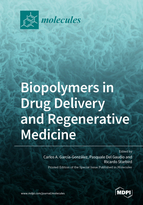Biopolymers in Drug Delivery and Regenerative Medicine
A special issue of Molecules (ISSN 1420-3049). This special issue belongs to the section "Medicinal Chemistry".
Deadline for manuscript submissions: closed (31 December 2020) | Viewed by 37823
Special Issue Editors
Interests: aerogels; supercritical fluids; regenerative medicine; pharmaceutical technology; 3D-bioprinting; porous materials; scaffolds; biomedical applications
Special Issues, Collections and Topics in MDPI journals
Interests: hydrogels; aerogels; controlled drug delivery; wound healing; carbohydrate polymers; microparticles; nanoparticles; nanocomposite; 3D printing
Special Issues, Collections and Topics in MDPI journals
Interests: polymer science; structuration of biomass and conductive polymers; composites and electrochemical sensors
Special Issues, Collections and Topics in MDPI journals
Special Issue Information
Dear Colleagues,
Biopolymers including natural (e.g., polysaccharides, proteins, gums, natural rubbers, bacterial polymers), synthetic (e.g., aliphatic polyesters and polyphosphoester), and biocomposites are of paramount interest in regenerative medicine, due to their availability, processability, and low toxicity. Moreover, the structuration of biopolymer-based materials at the nano- and microscale along with their chemical properties are crucial in the engineering of advanced carriers for drug products. Finally, combination products including or based on biopolymers for controlled drug release offer a powerful solution to improve the tissue integration and biological response of these materials. Understanding the drug delivery mechanisms, efficiency, and toxicity of such systems may be useful for regenerative medicine and pharmaceutical technology.
The main aim of the Special Issue on “Biopolymers in Drug Delivery and Regenerative Medicine” is to gather recent findings and current advances on biopolymer research for biomedical applications, particularly in regenerative medicine, wound healing, and drug delivery. Contributions to this issue can be as original research or review articles and may cover all aspects of biopolymer research, ranging from the chemical synthesis and characterization of modified biopolymers, their processing in different morphologies and hierarchical structures, as well as their assessment for biomedical uses.
Prof. Pasquale Del Gaudio
Dr. Eng. Carlos A. García-González
Dr. Ricardo Starbird
Guest Editors
Manuscript Submission Information
Manuscripts should be submitted online at www.mdpi.com by registering and logging in to this website. Once you are registered, click here to go to the submission form. Manuscripts can be submitted until the deadline. All submissions that pass pre-check are peer-reviewed. Accepted papers will be published continuously in the journal (as soon as accepted) and will be listed together on the special issue website. Research articles, review articles as well as short communications are invited. For planned papers, a title and short abstract (about 100 words) can be sent to the Editorial Office for announcement on this website.
Submitted manuscripts should not have been published previously, nor be under consideration for publication elsewhere (except conference proceedings papers). All manuscripts are thoroughly refereed through a single-blind peer-review process. A guide for authors and other relevant information for submission of manuscripts is available on the Instructions for Authors page. Molecules is an international peer-reviewed open access semimonthly journal published by MDPI.
Please visit the Instructions for Authors page before submitting a manuscript. The Article Processing Charge (APC) for publication in this open access journal is 2700 CHF (Swiss Francs). Submitted papers should be well formatted and use good English. Authors may use MDPI's English editing service prior to publication or during author revisions.
Keywords
- Biopolymer
- Drug delivery
- Regenerative medicine
- Wound healing
- Biodegradation
- Nanostructured carriers









